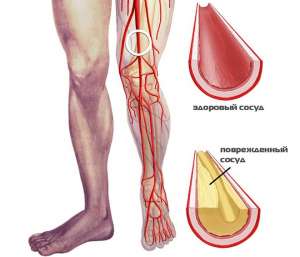The disease is a chronic inflammatory process in the arteries leading to the disorder gameovermenu, up to the complete overlap of the vascular lumen and the formation of gangrene.
Often use the term “obliterating endarteritis”. Obliteration or occlusion is a disorder of patency of the locking mechanism of the vascular walls.
More this disease (and obliterans – Buerger’s disease) affects males in middle age who have a habit – Smoking.
Etiological information
To date, experts have not reached a consensus about the causes of disease. Most suggest that the disease is autoimmune in nature. I.e. in the body begin to be produced antibodies, affecting the vascular wall. Next goes in the inflammatory process with the formation of connective tissue, the latter weselny constricts the lumen and compresses the vessel on the outside.
Reason products called antibodies again not fully elucidated.
There are other etiological theories of disease:
- allergic response to ingested nicotine;
- atherosclerosis of the lower limbs;
- disorder removablememory;
- various infectious processes.
It is known that the greatest risk of disease in smokers. Also, the pathological process may occur after prolonged stressful situations, or in the case of permanent hypothermia of the feet. Additionally, risk Supplement individuals with a history of frostbite of the feet.

Symptomatic picture
Clinical manifestations consist of manifestations in the lower extremities:
- Fatigue and heaviness, even with minor physical activity or walking.
- Feeling cold and swelling.
- The feeling of “pins and needles” and numbness.
- Increased sweating.
- Pallor of the skin.
- The development of ulcerative lesions leading to necrosis and gangrene.
- Brittle, cyanosis and deformation of the nail plate.
- Relief of pulse. In the later stages – the lack thereof.
- Convulsive status and pain during movement.
Further, such a pattern occurs and at rest. Pain develops in the calf muscle groups, it is sharp and quite severe, forcing the patient to stop. Spazmirovannah and pain after rest regress, it allows the patient to freely overcome a certain distance. Then the pattern is repeated. This condition is called intermittent claudication.
The development of the disease
For pathology is cyclical in nature with periods of exacerbation and remission.
Stands next stages of development:
- Article I (elementary). The lumen of the artery slightly narrowed, Samoobrona in the normal range. The signs do not manifest themselves practically. To diagnose at this stage much difficult.
- Article II (ischemic). There has been a slight deterioration in himosareena due to narrowing of the lumen. It is noted intermittent claudication, fatigue, cold lower extremities. Pulse more palpable. Mostly the diagnosis is exposed in this period. It is recommended to start immediately the conducting of therapeutic activities.
- Article III (trophic). Due to pronounced narrowing of the lumen and prolonged disorders of tissue blood circulation in the legs is a disorder of trophism. The clinical picture intensifitsiruetsa. The hair begins to fall out, nail plate become brittle and deformed, the integuments have a cyanotic shade. The pulse is felt extremely difficult. This stage is already advanced stage due to improper or lack of treatment.
- Article IV (ulcerative-necrotic). Develops complete obliteration of the entire vasculature of the lower extremities. Pulse is absolutely not palpable. Pain syndrome acquires stability. The patient is no longer able to move or walks with great difficulty and at a slight distance. In the muscles is atrophy. At the skin surface develop multiple ulcers formed tissue necrosis. Refers to extremely advanced forms of pathology, which are difficult to treat, especially developing destructive processes in the extremities.
- Article V (gangrene). Ignoring venous ulcers and necrosis gradually formed gangrene of the feet, which is of two varieties – dry and wet. In the first case the toes or the entire foot is dried, blackened, deformed and dies. In the second case, the tissues swell, the blood is produced by a large number of toxins. Shown here is only ampulirovannye limbs to prevent death from sepsis.
In advanced options, you may develop obstruction of the vascular network in the body.
Diagnosis
Define occlusive disease of the extremities can be in the early stages. Chances are directly dependent on the timeliness launched treatment.
For setting appropriate diagnosis carried out research:
- Capillaroscopic. Allows to estimate a condition of microcirculation in a particular area.
- Oscilloscope.
- Arteriographically(angiography). Helps to study the condition of the vessel, to determine the size of the pathological process.
- Reovazografija. Allows you to evaluate the speed of blood flow through the vessels and the degree of occlusion.
- Study of the dermal temperature (thermographic).
- Doppler. Helps to determine the condition of the tissues, or the degree of deformation and transformation.
Therapeutic tactics
Completely cure of the disease impossible. Treatment can slow the pace of development and to alleviate symptoms.
A special diet does not exist, you only need to stop Smoking and move a lot.
In severe cases operative intervention is performed way.
Drug therapy includes:
- Antispasmodic means.
- The vitamins (PP, B, C, E).
- Anticoagulants.
- Antihistamines.
Normalization of blood circulation in the legs show the following physiotherapeutic methods:
- Heat treatments – sauna, heating, ozokeritnye applications, etc.
- Baromassage lower extremities.
- The foot bath.
- Dynamic currents;
- Magnetoline.
In the case of ineffectiveness of conservative treatment shows operation.




I think I know what you’re saying, but I want some detail. Is it ok if I PM you?